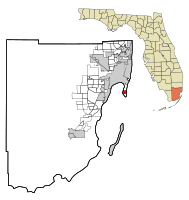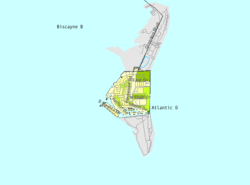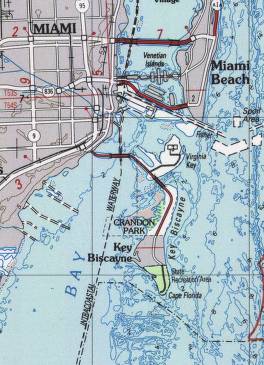Key Biscayne, Florida facts for kids
Quick facts for kids
Village of Key Biscayne
|
||
|---|---|---|
|
||
| Motto(s):
Island Paradise
|
||

Location in Miami-Dade County and the state of Florida
|
||

U.S. Census Bureau map showing village boundaries
|
||
| Country | ||
| State | ||
| County | ||
| Incorporated | June 18, 1991 | |
| Government | ||
| • Type | Council-Manager | |
| Area | ||
| • Total | 1.71 sq mi (4.42 km2) | |
| • Land | 1.25 sq mi (3.23 km2) | |
| • Water | 0.46 sq mi (1.19 km2) 8.63% | |
| Elevation | 3 ft (1 m) | |
| Population
(2020)
|
||
| • Total | 14,809 | |
| • Density | 11,875.70/sq mi (4,584.30/km2) | |
| Time zone | UTC-5 (Eastern (EST)) | |
| • Summer (DST) | UTC-4 (EDT) | |
| ZIP code |
33149
|
|
| Area code(s) | 305, 786 | |
| FIPS code | 12-36300 | |
| GNIS feature ID | 0285075 | |
Key Biscayne is an island town in Miami-Dade County, Florida, United States. The population was 12,344 at the 2010 census (on July 1, 2019 population was estimated as 12,846).
Key Biscayne lies south of Miami Beach and east of Miami. The village is connected to Miami via the Rickenbacker Causeway, originally built in 1947. Because of its low elevation and direct exposure to the Atlantic Ocean, it is usually among the first Miami areas to be evacuated before an oncoming hurricane.
Contents
Geography
According to the United States Census Bureau, the village has a total area of 1.4 square miles (3.6 km2). 1.3 square miles (3.4 km2) of it is land and 0.1 square miles (0.26 km2) of it (8.63%) is water.
The village is bordered on the north by Crandon Park, Miami-Dade County park, on the south by Bill Baggs Cape Florida State Park, on the east by the Atlantic Ocean and on the west by Biscayne Bay.
History
While there had been earlier schemes to develop a town on Key Biscayne, it wasn't until the opening of the four-mile (6 km) long Rickenbacker Causeway from Miami to Virginia Key and on to Key Biscayne in 1947 that the island was opened up to large scale residential development. The northern two-thirds of the island had been operated as the largest coconut plantation in the continental United States during the first half of the 20th century. In 1940 the Matheson family donated over 800 acres (3.2 km2) of their land to Dade County for a public park (Crandon Park) in exchange for a commitment that the county would build a causeway to the island. The remaining Matheson property, stretching across the middle of the island, was then sold off to developers. Starting in 1951, the Mackle Construction Company offered new homes on the island for US$9,540, with just US$500 down. A U.S. Post Office contract branch was opened, the Community Church started holding services in an old coconut-husking shed, and the Key Biscayne Elementary School opened in 1952.
The southern third of Key Biscayne, which included Cape Florida, was owned by James Deering and, after his death, by his brother Charles, for 35 years. In 1948 José Manuel Áleman, a Cuban politician in exile, bought the Cape Florida property from the Deering estate. After Áleman died in 1951, his widow, Elena Santeiro Garcia, added to her Cape Florida property by buying an ocean-to-bay strip that had been part of the Matheson property. This strip included a canal that had been dug by William Matheson in the 1920s, and which extended from the bay across most of the island. The land north of this canal was developed as part of what is now the Village of Key Biscayne. Garcia sold the Cape Florida property in 1966 to the state of Florida. This land became Bill Baggs Cape Florida State Park, which opened January 1, 1967.
President Richard Nixon purchased the first of his three waterfront homes, forming a compound known as the Florida White House, in 1969 to be close to his close friend and confidant, Bebe Rebozo and industrialist Robert Abplanalp (inventor of the modern spray can valve). Bebe Rebozo, owner of the Key Biscayne Bank, was indicted for laundering a $100,000 donation from Howard Hughes to the Nixon election campaign. President Kennedy and Nixon met for the first time after the 1960 Election loss by Nixon in an oceanfront villa at the old Key Biscayne Hotel. Plans for the Watergate break-in at Democratic headquarters were discussed at the Key Biscayne Nixon compound and, as the Watergate scandal unfolded, Nixon spent more time in seclusion there. Nixon visited Key Biscayne more than 50 times between 1969 and 1973. The U.S. Department of Defense spent $400,000 constructing a helicopter landing pad in Biscayne Bay adjacent to the Nixon compound and when Nixon sold his property, including the helicopter pad, there were public accusations that he enriched himself at taxpayer expense.
The area was incorporated as a new municipality in 1991 - the first new city in Miami-Dade County in over fifty years. Rafael Conte was elected the first mayor along with members of the founding Village Council including Clifford Brody, Mortimer Fried, Michael Hill, Luis Lauredo, Joe Rasco, and Raymond Sullivan. The municipality's first manager was C. Samuel Kissinger and the first clerk was Guido Inguanzo. The incorporation of the Village provided local control over taxes and future development.
In 1992, Hurricane Andrew flooded some homes and businesses on Key Biscayne but the eye wall passed over uninhabited Bill Baggs Cape Florida State Park which received the brunt of the storm. The storm damage was a blessing for the park because it destroyed all the non-native vegetation that the state had been trying to eradicate. Federal and State funding allowed the replanting with native vegetation making the park a showplace natural area. In recent years, the construction of several large resort hotels, condominium complexes and shopping centers on the island has affected the once bucolic island life, as commercialism has continued to accelerate at a frenetic pace. The Village has its own fire, police and public elementary and middle school. The millage tax rate remains one of the lowest of any municipality in Miami-Dade County. In 2004, the Village completed the construction of a civic center including fire, police and administration buildings and a recreation and community center with indoor multi use courts, outdoor swimming pool and a renowned musical theater program.
Climate
Key Biscayne exhibits a tropical monsoon climate despite some temperate influences which results in winter temperatures being more than 16F cooler than summer temperatures. Key Biscayne experiences hot, humid summers and mild, dry winters. Due to its island location, Key Biscayne is subject to cooler highs than Miami year-round. Extremes have ranged from 35°F in January 2010 to 96°F in April 2015. Hurricanes threaten the island occasionally, though landfalls are rare. Precipitation is lower than that of Miami, as the Atlantic Ocean inhibits summer thunderstorm convection.
| Climate data for Cape Florida, 2000-2010 normals, extremes 1895-present | |||||||||||||
|---|---|---|---|---|---|---|---|---|---|---|---|---|---|
| Month | Jan | Feb | Mar | Apr | May | Jun | Jul | Aug | Sep | Oct | Nov | Dec | Year |
| Record high °F (°C) | 88 (31) |
89 (32) |
93 (34) |
96 (36) |
96 (36) |
98 (37) |
100 (38) |
98 (37) |
97 (36) |
95 (35) |
91 (33) |
89 (32) |
100 (38) |
| Average high °F (°C) | 74.1 (23.4) |
75.6 (24.2) |
78.5 (25.8) |
80.3 (26.8) |
83.4 (28.6) |
86.8 (30.4) |
87.9 (31.1) |
88.0 (31.1) |
87.3 (30.7) |
84.4 (29.1) |
79.8 (26.6) |
76.4 (24.7) |
81.9 (27.7) |
| Average low °F (°C) | 59.7 (15.4) |
61.8 (16.6) |
64.2 (17.9) |
68.9 (20.5) |
73.7 (23.2) |
77.2 (25.1) |
78.0 (25.6) |
78.2 (25.7) |
77.6 (25.3) |
73.4 (23.0) |
67.9 (19.9) |
63.7 (17.6) |
70.4 (21.3) |
| Record low °F (°C) | 28 (−2) |
27 (−3) |
32 (0) |
39 (4) |
50 (10) |
60 (16) |
66 (19) |
67 (19) |
62 (17) |
45 (7) |
36 (2) |
30 (−1) |
27 (−3) |
| Average precipitation inches (mm) | 1.60 (41) |
1.74 (44) |
2.53 (64) |
2.78 (71) |
5.02 (128) |
7.32 (186) |
5.48 (139) |
6.26 (159) |
7.87 (200) |
5.98 (152) |
3.10 (79) |
1.91 (49) |
51.59 (1,312) |
| Average rainy days (≥ 0.01 in) | 7.3 | 6.2 | 6.6 | 6.0 | 9.4 | 15.9 | 15.8 | 15.2 | 16.1 | 11.9 | 8.9 | 7.5 | 126.8 |
| Source: [1] | |||||||||||||
Demographics
| Historical population | |||
|---|---|---|---|
| Census | Pop. | %± | |
| 2000 | 10,507 | — | |
| 2010 | 12,344 | 17.5% | |
| 2020 | 14,809 | 20.0% | |
| U.S. Decennial Census | |||
2020 census
| Race | Number | Percentage |
|---|---|---|
| White (NH) | 3,979 | 26.87% |
| Black or African American (NH) | 27 | 0.18% |
| Native American or Alaska Native (NH) | 3 | 0.02% |
| Asian (NH) | 106 | 0.72% |
| Some Other Race (NH) | 87 | 0.59% |
| Mixed/Multi-Racial (NH) | 719 | 4.86% |
| Hispanic or Latino | 9,888 | 66.77% |
| Total | 14,809 |
As of the 2020 United States census, there were 14,809 people, 4,422 households, and 3,263 families residing in the village.
2010 census
| Key Biscayne Demographics | |||
|---|---|---|---|
| 2010 Census | Key Biscayne | Miami-Dade County | Florida |
| Total population | 12,344 | 2,496,435 | 18,801,310 |
| Population, percent change, 2000 to 2010 | +17.5% | +10.8% | +17.6% |
| Population density | 10,070.7/sq mi | 1,315.5/sq mi | 350.6/sq mi |
| White or Caucasian (including White Hispanic) | 96.2% | 73.8% | 75.0% |
| (Non-Hispanic White or Caucasian) | 36.5% | 15.4% | 57.9% |
| Black or African-American | 0.4% | 18.9% | 16.0% |
| Hispanic or Latino (of any race) | 61.6% | 65.0% | 22.5% |
| Asian | 1.1% | 1.5% | 2.4% |
| Native American or Native Alaskan | 0.1% | 0.2% | 0.4% |
| Pacific Islander or Native Hawaiian | 0.0% | 0.0% | 0.1% |
| Two or more races (Multiracial) | 1.2% | 2.4% | 2.5% |
| Some Other Race | 1.0% | 3.2% | 3.6% |
As of 2010[update], there were 7,072 households, out of which 33.5% were vacant. In 2000, 32.3% had children under the age of 18 living with them, 58.0% were married couples living together, 7.7% had a female householder with no husband present, and 31.9% were non-families. 27.9% of all households were made up of individuals, and 9.5% had someone living alone who was 65 years of age or older. The average household size was 2.47 and the average family size was 2.99.
Other information
- Key Biscayne also hosts the Tennis Center at Crandon Park, home to the Miami Open Tennis Tournament, and a golf course, along with many amenities for water sports and fishing.
- Key Biscayne has a Visitors Center, open 24/7, 365 days a year, located in the Village Hall, 88 West McIntyre Street #100, adjacent to the Police Station. Staffed M-F from 9am to 5pm
Gallery
Education
Miami-Dade County Public Schools serves Key Biscayne. The Key Biscayne K–8 Center serves Key Biscayne. Middle school students may attend Ponce de Leon Middle School in Coral Gables instead of the Key Biscayne School. High school students are zoned to Coral Gables High School.
MAST Academy, a magnet school on Virginia Key, has since 2012 given eligible Key Biscayne residents priority in filling 1,100 seats in the school's Cambridge program.
The Miami-Dade Public Library System operates the 6,000-square-foot (560 m2) Key Biscayne Branch Library. It opened in January 1985.
St. Agnes Academy is a Catholic private school on the island located at 122 Harbor Drive, of the Roman Catholic Archdiocese of Miami. It serves pre-K–8th grade.
Notable people
- Jaime Bayly, writer
- Jay Berger (born 1966), tennis player; highest world ranking # 7
- Raul Boesel, race car driver
- Gaetano Ciancio, Transplant Surgeon
- Cher, actress and singer
- Isabel Pérez Farfante, carcinologist
- Mary Joe Fernandez, tennis star
- Timothy Ferris, author, went to Key Biscayne Elementary School
- Emerson Fittipaldi, ex-F1 and Indianapolis 500 winner, Indycar driver
- Fonseca (singer), Colombian Singer
- Andy Garcia, Actor
- Arthur Hanlon, American pianist
- Juanes, Colombian Singer
- Martin Margulies, billionaire art collector and fixture of Miami's high society
- Juan Pablo Montoya, Colombian Race car driver
- Richard Nixon, location of former President Nixon's Florida White House
- Brad Pitt, actor, once owned a home in Key Biscayne
- "Bebe" Rebozo, banker and confidante of Richard Nixon
- Eddie Rickenbacker and his wife Adelaide
Images for kids
-
Then U.S. President Richard Nixon at Key Biscayne's Fourth of July parade in 1969
-
The beach at Crandon Park in Key Biscayne, February 2008
See also
 In Spanish: Key Biscayne (Florida) para niños
In Spanish: Key Biscayne (Florida) para niños







